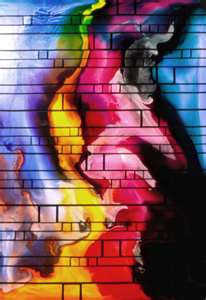Art is the process or product of deliberately arranging elements in a way to affect the senses or emotions.
HOME
▼
Thursday, April 26, 2012
Fabric Painting
About Fabric Painting-
Fabric painting is an excellent way to spruce up an old household item or garment without having to replace it with a new one. All you need are fabric paints and a few good ideas to add personality to anything from old tennis shoes to lampshades. Although it helps to have some artistic abilities, you don't have to be an accomplished artist to paint on fabric. By learning a few basic strokes, you can transform your wardrobe or fabric furnishings as well as make creative gifts.
Best Fabrics for Painting-Fabrics should be a natural fiber or natural blend. For best results, paint on washable 100 percent cotton fabric. However, rayons and silks will also work. Textured or colored fabrics might produce variations in colors, while white or cream-colored fabrics can somewhat dull paints. To be sure of the effect on a particular textile, first test your paint on scrap fabric.
Fabric Paints-The various fabric paints available can easily overwhelm a novice. Fabric paints range from translucent, opaque and acrylic paints to those made exclusively for textiles. Acrylics, which come in tubes, jars and bottles, can be mixed with other paints for creating new colors. You can also dilute them with water or acrylic mediums. When applied directly to the fabric, they dry stiff, so it's better to mix with some type of medium for softer finishes.
Brushes-Choose brushes based on the desired effects you plan to create. For example, flat shaders have a chiseled edge, making them suitable for making clean edges and in making the "S" stroke for painting leaves. They're also ideal for filling in large areas. Liner brushes are used for making stems, scrolls, tendrils and other flowing lines. Scrubbers have tapered round bristles that work well for stippling effects or blending colors.
Painting Techniques-Fabric painting techniques include reverse stamping, stamp printing, screen printing and scratching. Reverse stamping gives the look of batik fabrics and is done as a "wet" technique. One or more colors are layered onto a wet extender base. Using fingertips, gently smooth brush strokes. Stamp printing is done with stamps, either homemade or purchased. The technique involves stamping on fabrics such as unbleached cottons or calicos, which are heavier than muslin fabrics. Screen printing is a technique done on thick fabrics such as duck fabric. Scratching, which is similar to reverse stamping, involves removing painting with a stamp and is usually done on poplin fabric.
History-Fabric painting is an ancient art with printing blocks dating as far back as 3000 B.C. Painted fabrics were found in 327 B.C. in India, with the invasion of Alexander the Great. Trade routes developed, and painted Indian fabrics were traded not only throughout Asia and Egypt, but also in Africa and Europe. The Chinese were also producing block printing on fabric and sharing their stencil and resist techniques with Japan, as seen in the beautiful Japanese fabric patterning. Various other fabric painting techniques have continued to evolve throughout the world.
Warnings-When painting one-sided designs such as on T-shirts, add some newspaper sheets, cardboard or plastic inside the shirt to prevent paint from seeping to the back of the shirt. For best results, always use tightly woven fabrics, because they produce brighter results.






